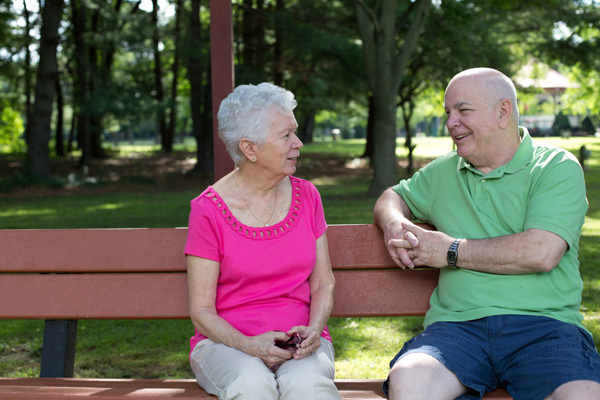"Having the monitor on and knowing they’re checking on you the whole time makes you feel comfortable to do the exercises."

Heart patients from al l walks of life come to cardiac rehab to get back to living.
When you enter the cardiac rehabilitation suite, it looks much like a regular gym. You will see different folks doing different activities, with different goals. What they have in common is a history of a heart problem, and the drive to improve their health.
For Judy and David, both of Hamilton, the coincidences don’t stop
there. Beyond family ties, these in-laws both found themselves on the
road to cardiac recovery at
the same time. Together, they worked back from very different heart conditions
to return to their lives.
Different Histories
Judy knew she would need heart surgery one day. When a mitral valve condition she’d been living with for years became symptomatic, her cardiologist, Neeta Tripathi, MD, said it was time, and she scheduled valve repair with a cardiovascular surgeon.
“Judy had been seeing me a long time and we knew that when she became symptomatic, surgery would be a consideration,” explains Dr. Tripathi. “When symptoms began to present, I recommended surgery because her health was otherwise fine.”
Around the same time, Judy’s brother-in-law, David, was experiencing a persistent pain in his shoulder. Thinking his problem was orthopedic in nature, David went to the orthopedist and had some imaging tests, but there was no evidence of a problem with the joint.
“It would hurt when I was sleeping, and sometimes when I’d walk my dogs or go up stairs,” says David.
When he went to his cardiologist, also Dr. Tripathi, she asked if he’d experienced any chest pain. David said no, but mentioned the shoulder pain. Dr. Tripathi was immediately concerned and sent him for a nuclear stress test. Sure enough, David’s shoulder was telling him he had a heart problem. One artery blocked 95% and another 70% had David on his way to have stents placed.
Navigating Rehabilitation
Cardiac rehabilitation is a monitored exercise program that helps patients
to control and maintain heart health.
Dr. Tripathi says most of the patients she refers for cardiac rehab have
a history of:
- Open heart surgery, including bypass and valve surgery
- Stenting
- Heart attack
- Congestive heart failure
“Cardiac rehab was mentioned following the surgery,” Judy recalls. “At first, I thought it might not be too much to come back from, but then I ended up needing a pacemaker. I knew I needed the rehabilitation.”
When she talked to David, they decided to embark on rehabilitation as a team.
“She said, ‘if you go, I’ll go,’” says David. “So we would go to each session together, three times a week.”
Judy admits she was nervous going into rehab, a common feeling among patients who have experienced a cardiac event or surgery.
“After a heart attack or heart surgery, people can be hesitant to get their heart rate going. Also, families can sometimes – understandably – be overprotective of cardiac patients,” Dr. Tripathi explains. “The cardiac rehab environment is the perfect safe place to develop a sense of confidence about doing physical activity again. These patients can recognize this is not the end of life, it’s the start of a new phase of life.”
In the program, each patient receives an individualized treatment plan from an exercise physiologist. This helps them understand their cardiac condition, promotes cardiovascular efficiency, improves general physical ability, and reduces anxiety through education and exercise. Then when they attend a session, nurses use cardiac monitoring equipment to keep track of the person’s vitals and ensure there is not a problem.
The Value of Cardiac Rehab
“Kelly, Diane and John gave me a lot of encouragement,” she says. “Having the monitor on and knowing they’re checking on you the whole time makes you feel comfortable to do the exercises.”
Beyond peace of mind for the patient, the cardiologist is also kept informed of the patient’s condition throughout the program. “If a patient is experiencing any problems, such as unstable vitals, dizziness or chest pain, the nurses will intervene immediately, contact the cardiologist,” says Dr. Tripathi.
For David, the value of cardiac rehab really came to light one day while attending a session.
“I came in just as I always did and had the monitoring equipment attached to start my workout. Within minutes, the nurse stopped me and began checking my vitals. One of my monitor leads was not in place and the data from the monitor was reading that something was wrong. The way they jumped into action to make sure I was okay was really impressive.”
David and Judy find themselves back to their normal everyday lives, getting together for family events and enjoying Judy’s famous seasoned pretzels.
“Cardiac rehab is so valuable for these patients,” says Dr. Tripathi. “During the program, it helps with compliance and reminds them what they need to be doing physically, with medications and nutritionally. Once they’re done, it brings back independence and puts their minds – and their family’s minds – at ease about what they can do.”